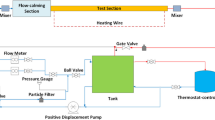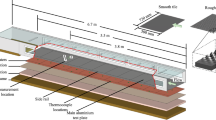Abstract
The results of calculating a supersonic turbulent boundary layer on a flat plate in the presence of thermal energy supply to the boundary layer are presented. Two methods of energy supply are considered: heating a local interval of the surface, which is otherwise thermally insulated and using a local volume heat source. It is shown that for the same amount of heat supplied to the gas volume heating leads, under certain conditions, to greater friction reduction than the surface heating. Localization of the energy supply zone leads to the intensification of the viscous drag reduction effect and to a greater decrease in the local friction coefficient, which extends a considerable distance downstream.
Similar content being viewed by others
References
A. V. Kazakov, M. N. Kogan, and V. A. Kuparev, "Stability of the subsonic boundary layer on the surface of a flat plate heated in the neighborhood of the leading edge,"Izv. Akad. Nauk SSSR, Mekh. Zhidk. Gaza, No. 3, 68 (1985).
I. A. Belov, V. M. Litvinov, A. V. Kazakov et al., "Stability of the laminar boundary layer and delayed transition on a nonisothermal surface,"Izv. Akad. Nauk SSSR, Mekh. Zhidk. Gaza, No. 2, 52 (1989).
V. V. Struminskii, A. V. Dovgal’, Yu. B. Lebedev et al., "Theoretical and experimental investigation of boundary layer stability for nonuniform surface heating, Preprint No. 3," [in Russian], Inst. Theor. Appl. Mech., Siberian Branch, USSR Academy of Sciences, Novosibirsk (1987).
D. M. Bushnell, "Turbulent drag reduction for external flows,"AIAA Paper, No. 227 (1983).
Yu. V. Lapin,Turbulent Boundary Layer in Supersonic Gas Flows [in Russian], Nauka, Moscow (1982).
C. Gavrin, J. F. Debieve, and A. J. Smits, "The near-wall temperature profile of turbulent boundary layer,"AIAA Paper, No. 136 (1988).
R. M. C. So, Y. G. Lai, H. S. Zhang, and B. C. Hwang, "Second-order near-wall turbulence closures: A review,"AIAA J.,29, 1819 (1991).
E. R. van Driest, "Turbulent boundary layer in compressible fluids,"J. Aeronaut. Sci.,18, No. 3, 145 (1951).
T. P. Sommer, R. M. C. So, and H. S. Zhang, "Near-wall variable-Prandtl-number turbulence model for compressible flows,"AIAA J.,31, 27 (1993).
T. Cebeci and A. M. O. Smith,Analysis of Turbulent Boundary Layers, Acad. Press, N. Y. (1974).
T. Cebeci and P. Bradshaw,Physical and Computational Aspects of Convective Heat Transfer, Springer, New York (1984).
Additional information
Moscow. Translated from Izvestiya Rossiiskoi Akademii Nauk, Mekhanika Zhidkosti i Gaza, No. 1, pp. 48–56, January–February, 1997.
The work was carried out with financial support from the Russian Foundation for Fundamental Research (project No. 93-013-17600).
Rights and permissions
About this article
Cite this article
Kazakov, A.V., Kogan, M.N. & Kuryachii, A.P. Effect of local heat supply to a turbulent boundary layer on the friction. Fluid Dyn 32, 39–45 (1997). https://doi.org/10.1007/BF02697935
Received:
Issue Date:
DOI: https://doi.org/10.1007/BF02697935




